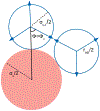Analytical 2-Dimensional Model of Nonpolar and Ionic Solvation in Water
- PMID: 33539097
- PMCID: PMC7958497
- DOI: 10.1021/acs.jpcb.0c10329
Analytical 2-Dimensional Model of Nonpolar and Ionic Solvation in Water
Abstract
A goal in computational chemistry is computing hydration free energies of nonpolar and charged solutes accurately, but with much greater computational speeds than in today's explicit-water simulations. Here, we take one step in that direction: a simple model of solvating waters that is analytical and thus essentially instantaneous to compute. Each water molecule is a 2-dimensional dipolar hydrogen-bonding disk that interacts around small circular solutes with different nonpolar and charge interactions. The model gives good qualitative agreement with experiments. As a function of the solute radius, it gives the solvation free energy, enthalpy and entropy as a function of temperature for the inert gas series Ne, Ar, Kr, and Xe. For anions and cations, it captures relatively well the trends versus ion radius. This approach should be readily generalizable to three dimensions.
Conflict of interest statement
The authors declare no competing financial interest.
Figures















Similar articles
-
Field-SEA: a model for computing the solvation free energies of nonpolar, polar, and charged solutes in water.J Phys Chem B. 2014 Jun 19;118(24):6431-7. doi: 10.1021/jp4115139. Epub 2013 Dec 13. J Phys Chem B. 2014. PMID: 24299013 Free PMC article.
-
Simple model of hydrophobic hydration.J Phys Chem B. 2012 May 31;116(21):6177-86. doi: 10.1021/jp300743a. Epub 2012 May 21. J Phys Chem B. 2012. PMID: 22564051 Free PMC article.
-
Unraveling water's entropic mysteries: a unified view of nonpolar, polar, and ionic hydration.Acc Chem Res. 2008 Aug;41(8):957-67. doi: 10.1021/ar7001478. Acc Chem Res. 2008. PMID: 18710198 Review.
-
Analytical theory of the hydrophobic effect of solutes in water.Phys Rev E. 2017 Sep;96(3-1):032101. doi: 10.1103/PhysRevE.96.032101. Epub 2017 Sep 1. Phys Rev E. 2017. PMID: 29347026 Free PMC article.
-
Recent developments in the theoretical, simulational, and experimental studies of the role of water hydrogen bonding in hydrophobic phenomena.Adv Colloid Interface Sci. 2016 Sep;235:23-45. doi: 10.1016/j.cis.2016.05.006. Epub 2016 May 18. Adv Colloid Interface Sci. 2016. PMID: 27312562 Review.
Cited by
-
Crustwater: Modeling Hydrophobic Solvation.J Phys Chem B. 2022 Aug 18;126(32):6052-6062. doi: 10.1021/acs.jpcb.2c02695. Epub 2022 Aug 4. J Phys Chem B. 2022. PMID: 35926838 Free PMC article.
References
-
- Hermann RB Theory of Hydrophobic Bonding. II. The Correlation of Hydrocarbon Solubility in Water with Solvent Cavity Surface Area. J. Phys. Chem 1972, 76, 2754–2759.
-
- Urbič T; Vlachy V; Kalyuzhnyi YV; Southall NT; Dill KA A Two-Dimensional Model of Water: Solvation of Nonpolar Solutes. J. Chem. Phys 2002, 116, 723–729.
-
- Urbič T; Vlachy V; Kalyuzhnyi YV; Dill KA Orientation-Dependent Integral Equation Theory for a Two-Dimensional Model of Water. J. Chem. Phys 2003, 118, 5516–5525.
-
- Urbic T; Vlachy V; Kalyuzhnyi YV; Dill KA Theory for the Solvation of Nonpolar Solutes in Water. J. Chem. Phys 2007, 127, 174505. - PubMed
Publication types
Grants and funding
LinkOut - more resources
Full Text Sources
Other Literature Sources
Research Materials

